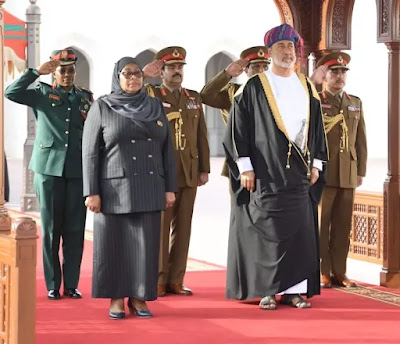During her official tour to Oman this year, Tanzania President Samia Suluhu Hassan rekindled the long-existing historical and rich heritage relations between Tanzania and the Sultanate of Oman.
Tanzania and Oman are now looking for a brighter future after almost 200 years of historical links with a heritage that is now attracting thousands of tourists to visit mainland Tanzania and mostly Zanzibar Island, famous for its heritage sites with roots from Oman.
The historical ties between Oman and Tanzania had partly changed during the German and British colonization of Tanzania, then the January 1964 revolution of Zanzibar ended the influence of Oman in Zanzibar and partly the Indian Ocean’s coast of Tanzania.
Today, the leading recorded and most documented historical heritage landmark between Oman and Tanzania is Dar es Salaam City, the former official residence of the ruler of Zanzibar, Sultan Seyyid Al-Majjid, and later the capital city of Tanzania. The former Zanzibar Sultan from Oman had established then named his once new administrative capital with the name of “Dar es Salaam” or “Haven of Peace,” the name that has been retained up to this day.
Dar es Salaam city whose name is a heritage of the Oman Sultanate is currently among the beautiful heritage cities in Africa with diversified cultural heritage with multi-racial integration, pulling tourists and visitors from various corners of the world. Sultan Majjid had established the Dar es Salaam city from a small fishing village of “Mzizima” that was occupied by the local African fishermen during those days. Dar es Salaam is now ranked among the fastest growing cities in Africa and had remained the capital and the commercial capital of Tanzania.
President Samia’s visit to Muscat was an indication aimed to rekindle the past glory, mostly the historical heritage which Oman had left in Zanzibar and the coast of Tanzania, seen through the beautiful Arab architecture, the Swahili culture, and ways of life to most of the people in mainland Tanzania and Zanzibar.
Addressing a gathering of business executives, investors, and diplomats from both Oman and Tanzania in Muscat, President Samia praised the now-growing cooperation and friendship between Tanzania and Oman.
“The Sultanate of Oman is a very special country to Tanzania. There is no other country in this planet with as many of its citizens who have blood relations with the people of Tanzania,” she said.
It is obvious that the depth of the relations is very special as Oman is the only country outside Africa with Swahili-related cultures familiar with Tanzanians.
The president undoubtedly wanted to revive the cooperation among the Omanis and Tanzanians, pegging to past relations. She said that her tour would envisage to forge closer economic, political, and cultural cooperation between Oman and Tanzania, developing from the longest shared history and common blood dating back to the 19th century.
Both Tanzania and Oman have rich natural endowments and boast strategic geographic positions which investors from both nations can exploit to expedite economic prosperity, Samia said. Other than historical and cultural heritages with roots from Oman, the history of Christian religion in Tanzania and Central Africa are well connected with the Oman sultanate. Zanzibar Sultan opened the door for European missionaries to enter his empire extending from the coast of Tanzania up to Congo and Zambia to spread the “World of God” – Christianity.
The Stone Town in Zanzibar is a United Nations Educational, Scientific and Cultural Organization (UNESCO) World Heritage site and is such an attractive site in Zanzibar by its unique and historical buildings of the early Omani Arabic architecture. While visiting Stone Town, one can see the former Slave Market and Anglican Cathedral, the House of Wonders, Sultans’ Palace Museum, the Old Arab Fort, and The House of Wonders or “Beit Al Ajaib” – the former residence of the Zanzibar Sultan – a huge square-shaped building with several flats surrounded by tiers of pillars and balconies. Guides at the building said it was built in 1883 as a ceremonial palace for Sultan Barghash and was the first in Zanzibar to have electric lights.
Ruins of the early Arabic architecture, slave trade, and the entry of Christianity to Tanzania and Central Africa are the major heritages found in Zanzibar and Bagamoyo on the coast of Tanzania, now pulling crowds of local and foreign tourists to visit.
Among the Oman architectural heritages seen today are the Old Boma near the port of Dar es Salaam that was constructed in 1867 to accommodate family guests of the Sultan, Seyyid Al-Majjid, whose palace was located next door. The Old Boma overlooks the Zanzibar port terminal at the Dar es Salaam main port. It is among the leading heritage sites with its historical background rooted from the Sultanate of Oman and Zanzibar. The building has Zanzibar-style carved wooden doors with its walls built with coral stones and its roof designed in Arabic architecture. It is currently under the management of the Dar es Salaam City Council, accommodating the Dar es Salaam Centre for Architectural Heritage (Darch), a tourist information center which hosts displays of the architectural evolution of Dar es Salaam. A short distance from the Old Boma, neighboring the Old Post Office in the city center, a visitor can see the White Father’s House which Sultan Majid built in 1865 to accommodate visitors.
Introduction of clove cultivation in Zanzibar has its roots from Oman after opening up clove farms in Pemba during those past years, along with coconut cultivation along the Tanzanian coastal zone. Other than cloves, Omani Arabs used Zanzibar and Pemba islands to produce spices, mostly nutmeg, cinnamon, and black pepper.
Views from various travel writers have attributed the Sultanate of Oman with the current development of tourism on the Tanzanian coast, basing on cultural and historical heritage that existed over 200 years ago.
https://eturbonews.com/
Tags: Tanzania President Samia Suluhu Hassan, Tanzania, Oman Tourism, Sultanate of Oman
